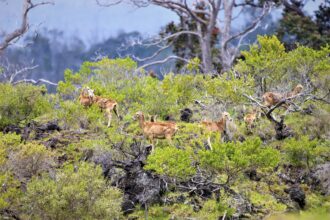Hooved mammals – ungulates in scientific parlance – aren’t native to the archipelago but have been brought to the islands over the past centuries. Now, population explosions of wild pigs, feral sheep and goats, big-horned mouflon sheep and axis and black-tailed deer are altering ecosystems, affecting fisheries, imperiling agriculture and causing economic harm.
“If you fly over the island of Lanai, it's just dirt,” said Melissa Price, an assistant professor at the University of Hawaii at Manoa. “I've never seen invasive grasses chewed down to the nubbins. I mean, this is not edible stuff and it's just down to the nubbins. Anytime there's rain, the deer populations move over to where the grass sprouts up and eat it before it gets a chance to take root. So that's impacting fisheries. It's impacting all kinds of stuff.”
But just how much damage those non-native ungulates are doing – the first step in understanding what could or should be done about it – hadn’t been documented.
“Most of the research that's been done on the impacts of non-native ungulates is on native ecosystems,” Price explained. “But the impacts on both agricultural systems and non-native-dominated ecosystems – which is most everything below a certain elevation – just hasn't been documented well. So when people ask us questions like, “How many pigs should there be? How many deer should there be? What can the land support?”, no one has great answers.”
So Price and colleagues at the University of Hawaii teamed up with research economist Stephanie Shwiff, a wildlife damage expert at the U.S. Department of Agriculture’s National Wildlife Research Center in Fort Collins, Colorado. They received a Western SARE Research and Education grant to document the dollar-value damage done by the deer, pigs and other ungulates and they began by just looking at the island’s’ pasture lands.
“What we really wanted to get at is the cost, the burden associated with these animals,” Shwiff said. “What are the costs associated with damage and what are the costs associated with control on ranchers’ parts?” Deer-proof fencing is expensive. Electric fencing is expensive. What are they paying for and how is that broken down?”
Having done similar work to document the damage done by wild pigs in the continental United States, Shwiff created a survey for Hawaii’s specific issues and got responses from producers managing 39 percent of the pasture acre in the islands.
“And we basically extrapolated that for all the pasture land and we calculate roughly between $3.6 and $7.5 million annually in impacts to Hawaii from these different wild ungulates,” Shwiff said. “Other research we've done show that producers that suffer this type of damage underestimate that damage by about threefold because of opportunity costs and other things that aren't included in the survey. So you start doing the math on that, it's a pretty significant impact.”
While that’s a number that can help argue for expanded support for fencing programs or increased state management efforts, coming up with that initial damage figure is just the beginning. The team will conduct field studies to validate the survey estimates and is developing additional fact-finding activities to document some of the ecosystem-level losses these non-native mammals are causing.
“For example, impacts to fisheries is something we've recognized for a while,” Price explained. “The mountain-to-ocean distance in the islands is so short that erosion upland dramatically impacts the reefs. One of my students in class yesterday, who grew up hunting and fishing, said there's no more near-shore fishery. They have to go way out to be able to catch any fish. Folks don't always see that connection, but if you’ve got too many pigs on the landscape, they are ecosystem engineers. They're turning over that soil. They're transforming it into a system that results in a ton of runoff. And you can watch when the rain happens, watch that red creep out in the water from the dirt coming off the land.”
But eliminating these species isn’t the goal. Managing them – and minimizing the damage they do – is.
“A lot of the farmers and ranchers want some number of animals on the landscape,” Price said. “They like providing their workers with hunting opportunities. And the family has hunting rights on lands that no one else can access, which is valuable. So there's a lot of folks who don’t want the number to be zero; they want to know what number of animals the land can handle.”
The ultimate goal of the three-year project is to answer those questions and look for culturally appropriate and economically viable methods to control these ungulate populations and minimize the damage they cause.
In that, it’s classic integrated pest management – just with very large pests. With hooves.
